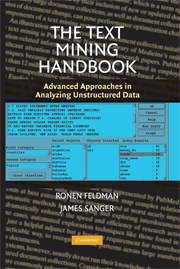Book contents
- Frontmatter
- Contents
- Preface
- I Introduction to Text Mining
- II Core Text Mining Operations
- III Text Mining Preprocessing Techniques
- IV Categorization
- V Clustering
- VI Information Extraction
- VII Probabilistic Models for Information Extraction
- VIII Preprocessing Applications Using Probabilistic and Hybrid Approaches
- IX Presentation-Layer Considerations for Browsing and Query Refinement
- X Visualization Approaches
- XI Link Analysis
- XII Text Mining Applications
- Appendix A DIAL: A Dedicated Information Extraction Language for Text Mining
- Bibliography
- Index
II - Core Text Mining Operations
Published online by Cambridge University Press: 08 August 2009
- Frontmatter
- Contents
- Preface
- I Introduction to Text Mining
- II Core Text Mining Operations
- III Text Mining Preprocessing Techniques
- IV Categorization
- V Clustering
- VI Information Extraction
- VII Probabilistic Models for Information Extraction
- VIII Preprocessing Applications Using Probabilistic and Hybrid Approaches
- IX Presentation-Layer Considerations for Browsing and Query Refinement
- X Visualization Approaches
- XI Link Analysis
- XII Text Mining Applications
- Appendix A DIAL: A Dedicated Information Extraction Language for Text Mining
- Bibliography
- Index
Summary
Core mining operations in text mining systems center on the algorithms that underlie the creation of queries for discovering patterns in document collections. This chapter describes most of the more common – and a few useful but less common – forms of these algorithms. Pattern-discovery algorithms are discussed primarily from a high-level definitional perspective. In addition, we examine the incorporation of background knowledge into text mining query operations. Finally, we briefly treat the topic of text mining query languages.
CORE TEXT MINING OPERATIONS
Core text mining operations consist of various mechanisms for discovering patterns of concept occurrence within a given document collection or subset of a document collection. The three most common types of patterns encountered in text mining are distributions (and proportions), frequent and near frequent sets, and associations.
Typically, when they offer the capability of discovering more than one type of pattern, text mining systems afford users the ability to toggle between displays of the different types of patterns for a given concept or set of concepts. This allows the richest possible exploratory access to the underlying document collection data through a browser.
Distributions
This section defines and discusses some of text mining's most commonly used distributions. We illustrate this in the context of a hypothetical text mining system that has a document collection W composed of documents containing news wire stories about world affairs that have all been preprocessed with concept labels.
- Type
- Chapter
- Information
- The Text Mining HandbookAdvanced Approaches in Analyzing Unstructured Data, pp. 19 - 56Publisher: Cambridge University PressPrint publication year: 2006



